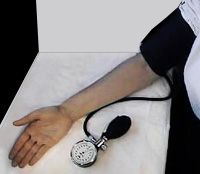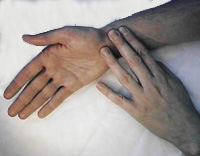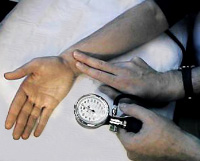|
Cardiovascular Laboratory |
Blood Pressure> Palpatory
Method |
| |
The relaxed subject sits on a chair. The cuff of the
sphygmomanometer is wrapped firmly around the right arm above the elbow. The lower arm
should be resting on a table-top or bench. |
|
 |
The radial pulse (the pulse at the radial artery in the
wrist) is palpated with the fingers of the left hand. The number of beats in 30
seconds is counted, and the heart rate in beats per minute is recorded. |
|

|
|
 |
The valve on the inflating bulb of the sphygmomanometer is
turned fully clockwise so that it is closed. The cuff is inflated slowly (10 mm
Hg/sec) by pumping the inflating bulb until the radial pulse is no longer felt. The
cuff is inflated further until the pressure is about 30 mm Hg higher. |
|
The valve on the inflating bulb is opened slightly by
turning it in the counterclockwise direction, allowing the pressure to drop slowly by
about 5 mm Hg/sec. At some point, one will be able to feel the radial pulse once
again. The pressure indicated on the gauge when the pulse reappears is noted.
This is the systolic pressure. Now the pressure in the cuff is quickly released, so
as not to cause undue discomfort to the subject. |
|
The determination of blood pressure is repeated two more
times for the right arm, and then repeated again using the left arm instead of the right
arm. |
Explanatory
Notes
|
|
To continue with the next section:
Auscultatory Method, click here |